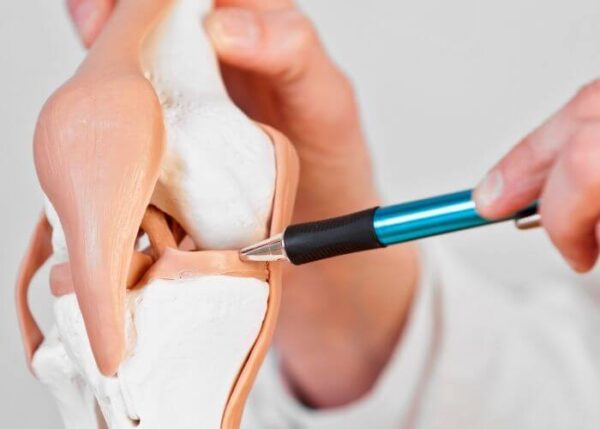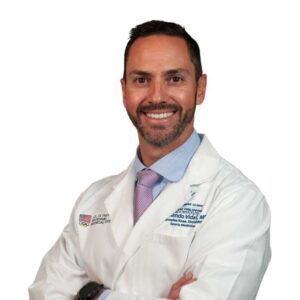What is a meniscus?
The knee joint is made up three bones that meet and form the knee joint. These bones are the femur (thigh bone), tibia (shinbone) and the patella (kneecap). The patella sits in front of the joint to provide protection. The ends of the bones are covered with a slippery substance called articular cartilage. This helps the knee bones glide smoothly across each other as the knee bends and straightens. Between the femur and the tibia are two C-shaped cushions of cartilage called the menisci. Each knee has two of these wedge-shaped “shock absorbers” to help cushion and stabilize the knee joint. When patients in Vail, Aspen and surrounding Denver, Colorado communities talk about a torn cartilage, they usually mean a torn meniscus. Dr. Armando Vidal, knee surgeon, specializes in torn menisci and can help patients return to their normal activities.

What is Meniscus Transplantation?
On occasion, especially with a traumatic injury, the meniscus is badly damaged and cannot be repaired. The damaged meniscus may need to be trimmed or removed completely. Without this cushion, the knee can develop painful arthritis. For many older patients, a knee joint replacement might be the best treatment, but very active people, younger than 55, may be able to receive an alternative treatment called meniscal transplant surgery.
Meniscus transplantation replaces a damaged meniscus with a donor meniscus. Ideally, the meniscus cushion is replaced before there is articular cartilage damage. The donor cartilage will support and stabilize the knee joint which relieves knee pain and may delay the need for a total knee replacement.
What is an allograft?
An allograft is a healthy cartilage tissue, taken from a human donor or cadaver. The tissue is tested, sized and stored in preparation for an exact size-match with a patient. The correct sizing of an allograft is paramount to the success of the treatment.
Meniscus transplantation surgery is extremely technically involved and requires an experienced surgical team to perform this surgery. Dr. Armando Vidal has extensive experience in this specialized surgery and can offer it for select patients in Vail, Aspen and the surrounding Denver, Colorado communities.
How is a meniscus transplant done?
Typically, a meniscus transplant is done arthroscopically, using a small, surgical camera and small surgical instruments to operate inside the knee joint. The inner and outer (medial and lateral) transplants involve making a small incision next to the patellar tendon and into the joint to slide the donated meniscus into place. The meniscus is then sewn into place and a tunnel is made to tuck the meniscus into its normal anatomical attachment site. This is called maintaining the “footprint” of the original meniscus.
Who is eligible for a meniscus transplant?
Meniscus transplants have been performed for more than 20 years throughout the world, yet the procedure is still relatively uncommon.
Meniscal transplants are indicated in three different scenarios.
- Symptomatic meniscal deficiency (meniscus was removed during surgery) without arthritis
- In the context of a more complicated joint preservation strategy
- Rarely in the case of revision ACL reconstruction if meniscal deficiency is felt to be a contributor to the failure
Strict patient criteria must be met to be considered for a meniscus transplant such as:
- Articular cartilage must be intact (or reconstructable) without excessive damage.
- Patients need to be younger than 55 and physically active.
- More than half of the meniscus is damaged as a result of a previous surgery, injury or a tear that cannot be repaired.
- Pain with activity that is persistent.
- Patient must have stable ligaments with normal bone alignment (or if instability or alignment are factors – these need to be addressed).
- Patient may not be obese.
How long is the recovery after meniscus transplantation?
After meniscus transplantation, patients must remain non weightbearing for the first six weeks to maximize healing. During that time, a knee brace must be worn to give the transplanted material time to adhere to the bone. Passive and active range of motion exercises will be performed to keep the knee joint flexible. When advised by Dr. Vidal and his team, strengthening exercises will be added to the rehabilitation program. Full recovery can take six to twelve months.
Can I run or jump after a meniscus transplant?
Meniscus transplants have been found to be successful in reducing pain and swelling with activities for 80% of the patients Dr. Vidal treats. However, returning to impact sports activities may not be advised. A donor allograft can last longer without the added stress of an impact sport and generally is not as strong as the original meniscus. Please talk with Dr. Vidal if you are considering a meniscus transplant and before returning to impact sports.
Meniscus Surgeon
Are you an athlete who participates in a high-impact sport? If so, you may be at risk for a severe meniscus tear. Severe tears of the meniscus typically must be treated surgically, often with a total knee replacement. For those who are very active and below the age of 55, a meniscus transplant may be an excellent alternative to a knee replacement. Complex knee surgeon, Doctor Armando Vidal provides diagnosis and meniscus transplant surgery for patients in Vail, Aspen, and the surrounding Denver, Colorado communities who are experiencing pain in the knee due to trauma. Contact Dr. Vidal’s team today!

Locations
180 S Frontage Rd W
Vail, CO 81657
226 Lusher Court
Ste 101
Frisco, CO 80443
322 Beard Creek Road
Edwards, CO 81632


